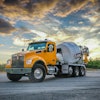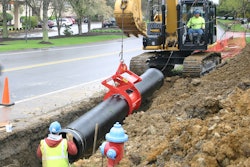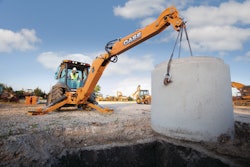
Edited by Hannah Schultz, Contributing Writer
It’s not uncommon for earthmovers to occasionally be tasked with lifting and placing heavy loads, such as pipe or trench boxes, on a project. Yet, each lift requires careful planning to ensure the safety of employees and equipment.
Following are five quick tips to help you get started toward safely completing these tasks. For specific guidelines, consult the operator’s manual for the particular machine that will be used.
1. Ensure the machine can handle the load
Exceeding the lifting capacity of an excavator or backhoe-loader could cause it to become unstable, increasing the risk of tipping or loss of control of the machine or load. This may result in injury to personnel and damage to the machine, site or payload. It can also place undue stress on systems and components, which may lead to maintenance issues, failures and costly downtime and repairs down the road.
The proper machine will have the size and capacity to maintain stability and control throughout the lift, while providing sufficient lift height and reach to place the material where it’s needed. It must also be capable of safely lowering the load into a hole or trench as required.
2.Understand the machine’s load charts
Manufacturers determine how much weight an excavator or backhoe-loader model and configuration can safely lift. Machine capacity is constantly changing based on the boom’s working range and position. Load charts designate the lifting capacity at various angles, heights, reach and swing radii.
Operators should be trained how to read and follow the load charts for the machine, and have a thorough understanding of its capabilities prior to the lift. Make sure they can identify the rated lift capacities at various positions around the machine.
3. Determine the total weight of the load
Prior to any lift, it’s vital that you know the weight of the material to be moved. Many types of construction materials, such as concrete pipe, will have weights available from the supplier. Be sure to contact the proper individual on site who can provide this information.
Yet, knowing a load’s weight is only the starting point. The total load weight must also take into account the machine configuration and any items that may add weight to the lifting end of the machine, such as buckets, thumbs and couplers. The weight of these items must be subtracted from the total weight the unit can lift at the particular reach or angle required.
If the total weight of a load can’t be determined, proceed with caution. Conduct a test lift if there is any question about the machine’s ability to handle the load, making sure the load is picked close to the machine, kept close to the ground and slowly extended and swung into place.
4. Check the site and the machine
Before starting the lift, check the surrounding area for obstacles or hazards (e.g., overhead utilities) within the lift zone. Make sure the machine is positioned on a firm, level and stable surface. Avoid lifting on soft, uneven or unstable ground. Use mats, wood platforms or steel plates to provide a more solid work platform if needed.
The operator should check that the controls are set to the preferred control pattern and that he or she is familiar with the functions of that particular machine. A safety check should also be conducted on the machine to ensure it is in good condition and is operating properly.
If the machine is equipped with a blade, the blade should be placed on the ground for added stability. Make sure the necessary counterweights are in place.
In the case of a backhoe-loader, stabilizers should be lowered so that the tires are lifted slightly off the ground. The loader bucket should be placed on the ground for further stability.
Check the rigging to ensure it is appropriate to the application and rated to handle the load. Inspect it before each use for any signs of damage or wear, and make sure it is properly secured to the machine and load.
Finally, clear the area of any unnecessary personnel. The spotters should be the only individuals in the immediate area, and should be stationed clear of the lift area yet visible to the equipment operator throughout the lift.
5. Keep it low and slow
Keep in mind that an excavator or backhoe-loader will have its highest lifting capacity closer to the machine. Lift the load squarely over the side or end of the machine. Keep the load as close to the machine and the ground as possible as you move it, then extend the load out to place it in the desired location. Use slow movements to help ensure a controlled operation.
The operator should be positioned to be able to maintain visibility into the hole or trench as the load is being lowered. Position the machine so that the lowering will be done over the end of the machine and not over the side.
Keep the lift point directly over the load. The load can become unbalanced if the line is twisted and starts to rotate. Short slings can be used to prevent excessive load swing. Tag lines can help control the load and prevent swinging or swaying during the lift.
If there are any signs of instability or loss of control of the machine or load, discontinue the lift and lower the load to the ground.




















